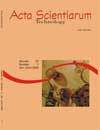Microcystins: contamination risks in eutrophic waters
DOI:
https://doi.org/10.4025/actascitechnol.v22i0.3010Keywords:
microcistinas, cianobactéria, produção, atividade tóxica, detoxicaçãoAbstract
Population growth allied with the modernization of society has increased water consumption and transformed reservoirs into indispensable sources of water supply. Several interrelated factors, conspicuously microcystins, have contributed to aggravate the risk of water deterioration. These hepatotoxins, produced by cyanobacteria of the Anabaena, Microcystis, Nostoc and Oscillatoria geni, consist of heptapeptides with monocyclic structures. The risk of constant ingestion is due to their powerful tumor promoter effect. The microcystin production is favored by environmental factors, such as high concentration of nutrients and light, inevitable in the current ecosystem. The eutrophycation of water occurs in an accelerated rhythm due to industrial pollution coupled to domestic and agricultural waste. The aim of this paper is to develop community awareness, as well as to arouse an interest in microcystins and other risk factors of contamination so that preventive measures to minimize water deterioration could be established.Downloads
Download data is not yet available.
Downloads
Published
2008-05-13
How to Cite
Kamogae, M., & Hirooka, E. Y. (2008). Microcystins: contamination risks in eutrophic waters. Acta Scientiarum. Technology, 22, 1189–1200. https://doi.org/10.4025/actascitechnol.v22i0.3010
Issue
Section
Chemical Engineering
License
DECLARATION OF ORIGINALITY AND COPYRIGHTS
I Declare that current article is original and has not been submitted for publication, in part or in whole, to any other national or international journal.
The copyrights belong exclusively to the authors. Published content is licensed under Creative Commons Attribution 4.0 (CC BY 4.0) guidelines, which allows sharing (copy and distribution of the material in any medium or format) and adaptation (remix, transform, and build upon the material) for any purpose, even commercially, under the terms of attribution.
Read this link for further information on how to use CC BY 4.0 properly.











8.png)




